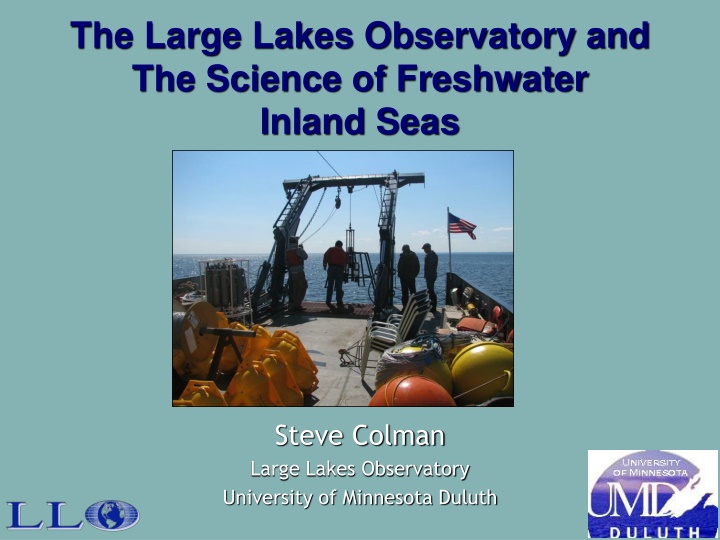The Large Lakes Observatory and The Science of Freshwater Inland Seas
The Large Lakes Observatory (LLO) at the University of Minnesota Duluth is a leading academic program focused on limnology, oceanography, and research dedicated to inland seas. LLO's unique focus on oceanographic research methods applied to large lakes worldwide is supported by the Blue Heron research vessel and interdisciplinary research in mathematics. The need for basic research in understanding large lakes is crucial for effective management and utilization in transportation, fisheries, recreation, and water supply. LLO also collaborates with Great Lakes agencies and Coastal Observatories for monitoring and modeling efforts.
Download Presentation

Please find below an Image/Link to download the presentation.
The content on the website is provided AS IS for your information and personal use only. It may not be sold, licensed, or shared on other websites without obtaining consent from the author.If you encounter any issues during the download, it is possible that the publisher has removed the file from their server.
You are allowed to download the files provided on this website for personal or commercial use, subject to the condition that they are used lawfully. All files are the property of their respective owners.
The content on the website is provided AS IS for your information and personal use only. It may not be sold, licensed, or shared on other websites without obtaining consent from the author.
E N D
Presentation Transcript
The Large Lakes Observatory and The Science of Freshwater Inland Seas Steve Colman Large Lakes Observatory University of Minnesota Duluth
LLO and its Multiple Missions Founded in 1994, largest academic program in limnology in the country Unit of the Swenson College of Science and Engineering, UMD Faculty have split appointments with LLO and other academic departments Missions: Research dedicated to the science of inland seas Graduate program in limnology and oceanography, Undergraduate education, in partnership with UMD departments
LLO is Unique Focus on oceanographic research methods applied to inland seas Global perspective: Large lakes of the world
The Blue Heron Largest university-owned research vessel on the Laurentian Great Lakes Berths for 11 Part of the University National Oceanographic Laboratory System Multiple types of SONAR, Seabird CTD & niskin bottle carousel, flow-through water system, corers, plankton nets, trawling capability
Interdisciplinary Research at LLO Mathematics-- The foundation of all
Why basic research? We need to understand how large lakes work To be effective guardians To anticipate and respond to surprises To use them effectively Transportation Fisheries, commercial and sport Recreation Water supply Satellite photo, why basic
Great Lakes agencies and GLOS GLOS: part of IOOS Focused on monitoring LLO maintains moorings and deploys an autonomous glider as part of this effort Also does modeling work
Some techniques for assessing lake productivity Sediment traps similar to this one deployed in Lake Superior are being moored in Lake Malawi for several years Sedimenting particles from phytoplankton productivity are collected sequentially
In-situ fluorometry used to estimate phytoplankton composition & productivity Some of the instruments we use include FluoroProbe, Fast Repetition Rate Fluorometer, Flow Cytometer and Inverted Microscopy
Sediment geochemistry in Lake Superior
Physics and geochemistry of stratified tropical lakes L. Kivu (Rwanda) L. Matano (Indonesia) L. Malawi (Malawi)
Some recent discoveries Understanding the heat, carbon, and nutrient budgets of Lake Superior Circulation and ice modeling Radiocarbon budgets Fluxes at the sediment surface Using Crenarchaeota lipids to investigate past lake temperatures Mapping of lake floor features
What about Ice? Mean ice cover decreasing steadily over period of record: ~0.42%/yr
Crenarchaeota marine Crenarchaeota (<1 m) bacteria Hydrophilic head groups Hydrophilic head groups Hydrophobic interior Slide courtesy of Johan Weijers
TEX86 Global Lake Calibration Mean Square Error = + 2 oC Powers et al. 2004
Radiocarbon and Lake Superiors carbon cycle McNichol and Aluwihare, 2007 Atmospheric 14C (2009) = 38 Lake Superior surface DIC 14C (2009) = 56.2 to 60.9
D D14C (June 2009) 100 50 0 WM CM EM SM NM ONT BR NB -50 per mille -100 -150 DIC (surf) DIC (mid) zoop POC (surf) POC (mid) -200 -250 -300 -350 2009 corn 14C = 38 2
D D14C (August 2009) DIC (surf) DIC (mid) zoop POC (surf) POC (mid) 80 65 50 35 per mille 20 5 WM CM EM SM NM ONT BR NB -10 -25 -40 2009 corn 14C = 38 2
Sea Floor Mapping Tools Surficial and Sub-bottom Systems Sidescan-sonar Seismic Reflection Swath Bathymetry
Sidescan sonar images, off Superior Entry N Sand wave field Glacial deposit outcrop 100m N 100m Anchor drag marks
Current LLO projects include Studying the role of zooplankton migration and its effects on Lake Superior s chlorophyll maximum Looking at the effects of climate change on Lake Malawi s productivity Investigating the climate change history of the Tibetan Plateau Identifying methane resources and hazards in Lake Kivu
LLO facilities Flow cytometer (BD FACSCaliber) Itrax XRF scanner IR-MS (ThermoFinnegan Delta Plus XP) LC-MS(Agilent triplequad)
Lake Effect Thank you!























